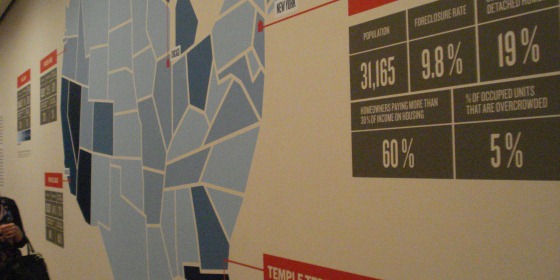I’ve written a few times about the notion of smart cities and with my recent travels to New York, I thought it would be interesting to highlight a new exhibition at the Museum of Modern Art. The recent foreclosure crisis has taken a heavy toll on these seemingly staid, safe communities, leaving empty houses and unfinished construction in cities that were meant to be prosperous and ever-expanding. This prompted five interdisciplinary teams of architects, urban planners, ecologists, engineers and landscape designers to spend the summer of 2011 rethinking the basic concept of the suburb. The result is “Foreclosed: Rehousing the American Dream,” on display at MoMA through July 30th.
Working in response to a research report from the Buell Center at Columbia University — “The Buell Hypothesis” — each team focused on a specific suburb located along an existing or planned light-rail line linking it to major metro areas. The teams developed plans for the communities that go beyond new building designs to re-think the connection between town and nature, the facilities for managing waste and energy, and even the mechanisms of mortgages and residential ownership. The exhibition shows architectural models, illustrations of the newly re-engineered communities, video interviews with residents of the cities, and facts and figures putting the mortgage crisis into context for each location. You can also find “Foreclosed” online, with an interactive site featuring a blog extending from the early days of the summer workshops, videos, and a downloadable version of “The Buell Hypothesis.”
The re-envisioned suburbs are intended to support a spectrum of life and daily use. In Keizer, Oregon, “Nature City” features residential building designs that seamlessly incorporate key infrastructure such as wastewater treatment facilities and a composting hill that generates fuel through methane extraction. In Temple Terrace, Florida, houses are structured to shelter residents from the hottest southern sun, and multi-use construction brings together retail and business space with apartments and single-family houses. And in Cicero, Illinois, the “Recombinant House” enables residents to add or remove modular space as families grow or children leave the nest.
The “Foreclosed” project doesn’t just lay out clever ideas in architectural design, but steps back to re-examine the fundamental assumption of suburban life: that a prosperous community is built on single-family houses spread out over a wide area. The cities on display have suffered under that old vision of the American Dream. “Change the dream and you change the city,” argues “The Buell Hypothesis,” and the proposals laid out here suggest that there are several ways to reclaim that vision of prosperity.






